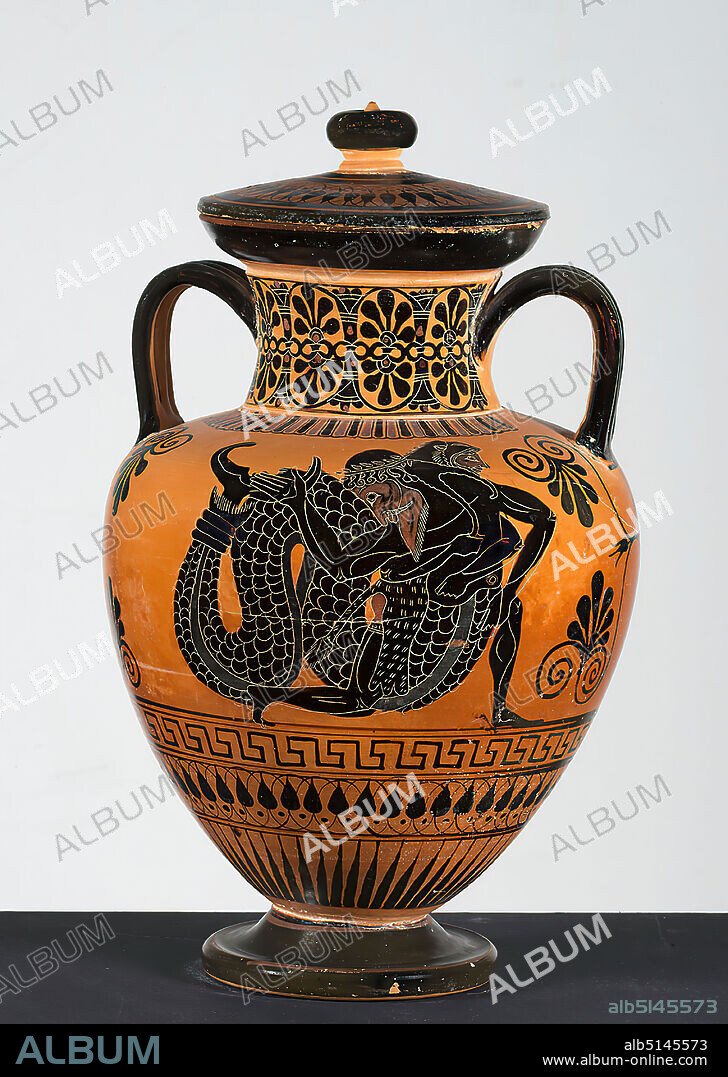alb5145573
Antimenes painter, neck amphora with lid (Heracles fights with Nereus, Menelaos and Helena), clay, quickly turned, painted (ceramic), alternately fired, clay, turned and painted, total: height: 36.4 cm; mouth diameter: 14.2 cm; base diameter: 12.2 cm, incised mark: under the foot, pottery, Nereus, Hercules forces Nereus to tell him the way to the Hesperides, Menelaus and Helena, ornaments, late archaic, The neck amphora with triple ribbed handles and the presumably originally belonging lid shows only few splinters. From the foot upwards, the following ornamental sequence results: corona, bud arch frieze with dots and a hook meander. On the shoulder there is a colored alternating tongue leaf pattern, which is interrupted under the handles. The neck is decorated with a double lotus-palmette ribbon directed against each other. The lid is again decorated with a bud arch frieze. The handle is formed in the shape of a pomegranate. On side A, Heracles sits astride the winding, scaly body of Nereus in a kneeling pattern and has embraced him with both arms from behind. The latter has a huge head, a long beard and wears a myrtle wreath in his hair. The lowered head and the helplessly stretched out right arm seem to indicate that Heracles will defeat him immediately. The Hero can be recognized by his lion skin. Long before the first literary testimony, Heracles' battle with Nereus appears on Attic vases, almost without exception black-figured. The theme was particularly popular in the second half of the 6th and at the beginning of the 5th century B.C. The mythographer Pherekydes of Leros, who was active around the middle of the 5th century B.C, was the first to report a connection between the sea god Nereus and the deeds of Heracles and the search for the apples of the Hesperides. Already in the Iliad, Nereus is mentioned, but not by name, but as the 'Old Man of the Sea'; in the Odyssey this is his epithet. He is described as a shape-shifter, who possesses the gift of prophecy.

|
Zu einem anderen Lightbox hinzufügen |
|
Zu einem anderen Lightbox hinzufügen |



Haben Sie bereits ein Konto? Anmelden
Sie haben kein Konto? Registrieren
Dieses Bild kaufen.
Nutzung auswählen:

Untertitel:
Siehe automatische Übersetzung
Antimenes painter, neck amphora with lid (Heracles fights with Nereus, Menelaos and Helena), clay, quickly turned, painted (ceramic), alternately fired, clay, turned and painted, total: height: 36.4 cm; mouth diameter: 14.2 cm; base diameter: 12.2 cm, incised mark: under the foot, pottery, Nereus, Hercules forces Nereus to tell him the way to the Hesperides, Menelaus and Helena, ornaments, late archaic, The neck amphora with triple ribbed handles and the presumably originally belonging lid shows only few splinters. From the foot upwards, the following ornamental sequence results: corona, bud arch frieze with dots and a hook meander. On the shoulder there is a colored alternating tongue leaf pattern, which is interrupted under the handles. The neck is decorated with a double lotus-palmette ribbon directed against each other. The lid is again decorated with a bud arch frieze. The handle is formed in the shape of a pomegranate. On side A, Heracles sits astride the winding, scaly body of Nereus in a kneeling pattern and has embraced him with both arms from behind. The latter has a huge head, a long beard and wears a myrtle wreath in his hair. The lowered head and the helplessly stretched out right arm seem to indicate that Heracles will defeat him immediately. The Hero can be recognized by his lion skin. Long before the first literary testimony, Heracles' battle with Nereus appears on Attic vases, almost without exception black-figured. The theme was particularly popular in the second half of the 6th and at the beginning of the 5th century B.C. The mythographer Pherekydes of Leros, who was active around the middle of the 5th century B.C, was the first to report a connection between the sea god Nereus and the deeds of Heracles and the search for the apples of the Hesperides. Already in the Iliad, Nereus is mentioned, but not by name, but as the 'Old Man of the Sea'; in the Odyssey this is his epithet. He is described as a shape-shifter, who possesses the gift of prophecy
Bildnachweis:
Album / quintlox
Freigaben (Releases):
Model: Nein - Eigentum: Nein
Rechtefragen?
Rechtefragen?
Bildgröße:
3071 x 4320 px | 38.0 MB
Druckgröße:
26.0 x 36.6 cm | 10.2 x 14.4 in (300 dpi)
Schlüsselwörter:
5. JAHRHUNDERT V. CHR. • 5. JH. V. U. Z. • 6. JAHRHUNDERT • 6. JH. • AEPFEL DER HESPERIDEN • AKTIV • ARKTIS • BRUDER • DEKORATION • EINFUSSER • EINFÜSSER • ERSTER, ERSTE, ERSTES • FEUER, KRIEG • FORM • FRUCHT: GRANATAPFEL • FUSS • GESPRÄCH • GRANATAPFEL • GRIECHE • GRIECHIN • GRIECHISCH • GRIFF • HAAR (HAARE) • HAARE (HAAR) • HAARE • HALS • HELD • HELDEN, ALLE • HELLENISTISCH • HELM • HENKEL • HEROS • HESPERIDEN • HIMATION • KERAMIK • KRIEG • KURVIG • MUTTER • NACKEN • NIPPES • NORDPOL • OMEN • ORAKEL • ORNAMENT • ORNAMENTE • PARIS • PARIS, FRANKREICH • PROPHEZEIUNG • SCHLAF (SCHLAFEN) • SCHLAF • SCHLAFEN (SCHLAF) • SCHLAFEN • SCHULTER • SCHUTZHELM • SCHWERT • STADT • STEINGUT • STÄDTE • TOD • TODESFALL • TOEPFEREI • TOEPFERWARE • TON • TÖPFEREI • VATER • VERZIEHRUNG • VERZIERUNG • WAHRSAGEREI • WEISSAGUNG • ZIERDE • ÄPFEL DER HESPERIDEN
 Pinterest
Pinterest Twitter
Twitter Facebook
Facebook Link kopieren
Link kopieren Email
Email
